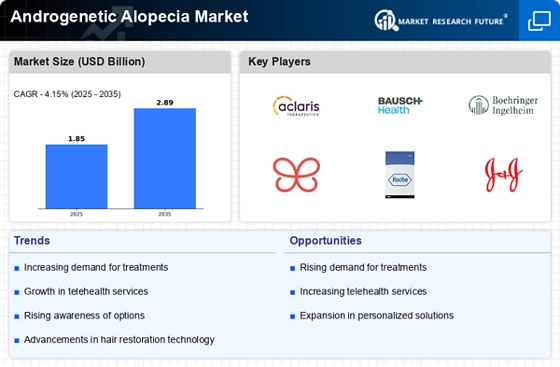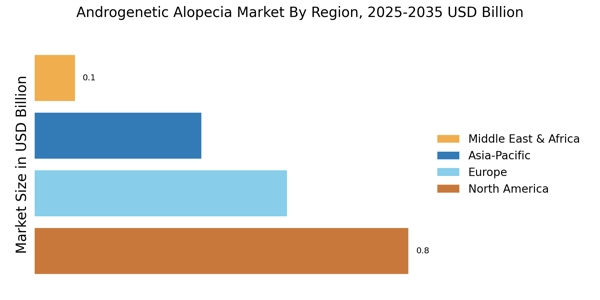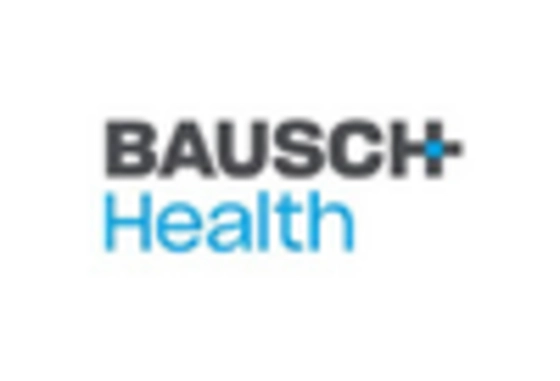Growing Demand for Personalized Treatments
The shift towards personalized medicine is becoming increasingly evident in the Androgenetic Alopecia Market. Consumers are seeking tailored solutions that address their specific hair loss patterns and underlying causes. This trend is prompting manufacturers to develop customized treatment plans, including topical solutions and oral medications that cater to individual needs. Market Research Future indicates that personalized treatments are gaining traction, as they often yield better results compared to one-size-fits-all approaches. Furthermore, the rise of genetic testing is enabling more precise targeting of therapies, which could enhance patient satisfaction and adherence. As the demand for personalized solutions grows, the Androgenetic Alopecia Market is likely to adapt, fostering innovation and competition among providers.
Advancements in Hair Restoration Technologies
Technological innovations in hair restoration are significantly influencing the Androgenetic Alopecia Market. The introduction of advanced techniques such as follicular unit extraction (FUE) and robotic hair transplantation has revolutionized treatment options. These methods offer minimally invasive solutions with improved outcomes, attracting a broader patient base. Market data suggests that the hair restoration segment is experiencing robust growth, with a projected increase in revenue driven by these advancements. Additionally, the integration of artificial intelligence in treatment planning and patient management is enhancing the overall effectiveness of therapies. As these technologies continue to evolve, they are likely to reshape the landscape of the Androgenetic Alopecia Market, making treatments more accessible and effective.
Increasing Prevalence of Androgenetic Alopecia
The rising incidence of androgenetic alopecia is a primary driver for the Androgenetic Alopecia Market. Studies indicate that approximately 50 million men and 30 million women experience some degree of hair loss due to this condition. This growing prevalence is likely to escalate demand for effective treatment options, thereby propelling market growth. As awareness of hair loss issues increases, more individuals are seeking solutions, which could lead to a surge in product development and innovation within the industry. Furthermore, the aging population is expected to contribute to this trend, as hair loss becomes more common with advancing age. Consequently, the Androgenetic Alopecia Market is poised for expansion as it addresses the needs of a larger demographic.
Expansion of E-commerce Platforms for Hair Loss Products
The proliferation of e-commerce platforms is transforming the distribution landscape of the Androgenetic Alopecia Market. Consumers are increasingly turning to online shopping for convenience and access to a wider range of products. This trend is particularly relevant for hair loss treatments, as individuals often prefer the privacy of purchasing such products online. Market analysis indicates that e-commerce sales in the beauty and personal care sector, including hair loss solutions, are on the rise. The ability to compare products, read reviews, and access expert advice online is enhancing consumer confidence in their purchasing decisions. As e-commerce continues to expand, it is likely to play a pivotal role in shaping the future of the Androgenetic Alopecia Market, making treatments more accessible to a global audience.
Increased Awareness and Acceptance of Hair Loss Treatments
There is a notable increase in awareness and acceptance of hair loss treatments among consumers, which is positively impacting the Androgenetic Alopecia Market. Educational campaigns and social media influence are playing crucial roles in destigmatizing hair loss and promoting available solutions. As more individuals recognize that effective treatments exist, the market is witnessing a surge in inquiries and purchases. Data suggests that the global market for hair loss treatments is expected to reach substantial figures in the coming years, driven by this heightened awareness. Additionally, the growing acceptance of cosmetic procedures is likely to encourage more people to seek out treatments for androgenetic alopecia, further fueling market growth. This cultural shift is essential for the ongoing evolution of the Androgenetic Alopecia Market.


















Leave a Comment